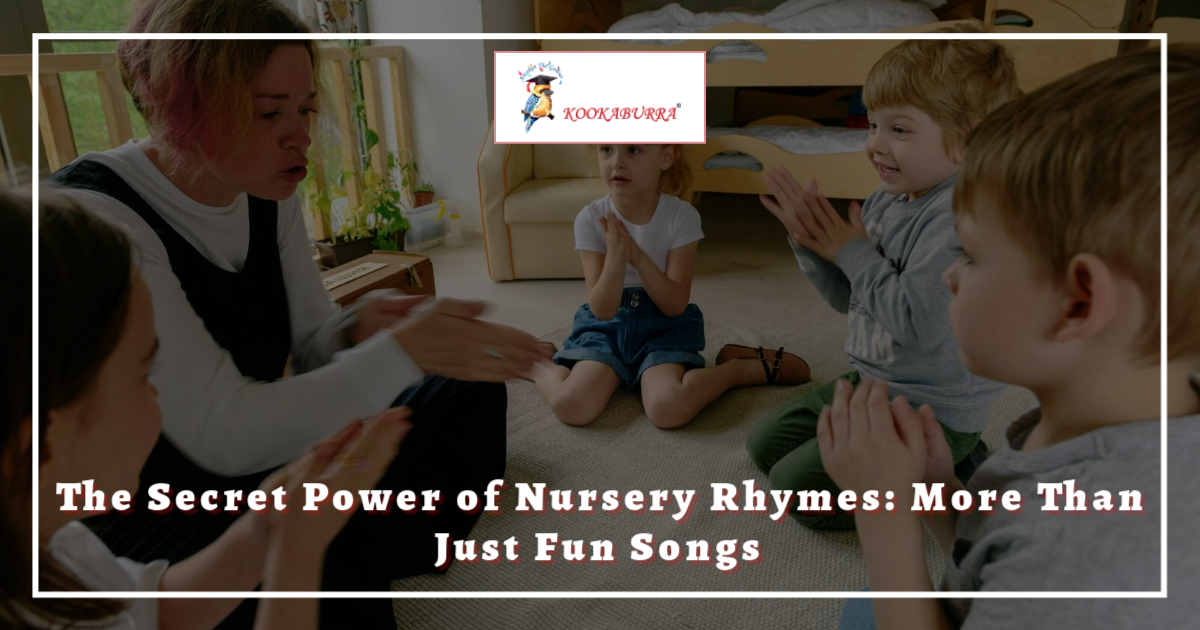
The Secret Power of Nursery Rhymes: More Than Just Fun Songs
Tick-tock, tick-tock, the clock sings a rhythmic lullaby. A mother hums Twinkle, Twinkle, Little Star as her child sways gently in her arms. A classroom full of giggles erupts as little feet stomp to the beat of The Wheels on the Bus. To the untrained eye, these may seem like playful moments, fleeting and lighthearted. But beneath the melody lies an unseen force, a secret power that profoundly shapes young minds.
Before a child learns to read or write, they first learn to listen. Nursery rhymes, wrapped in rhythmic beauty, are the earliest teachers of phonemic awareness. Repetitive patterns in Humpty Dumpty or Baa Baa Black Sheep engrain language structures, enhancing speech and literacy skills. Studies show that children exposed to nursery rhymes develop stronger reading abilities by recognising word structures and anticipating sounds long before formal education begins.
Power of Nursery Rhymes in Childhood Development
1. Cognitive Growth and Mathematical Awareness
Ever wondered why you can recall childhood rhymes decades later but struggle to remember last week’s grocery list? The answer lies in the enchanting connection between rhythm and memory. Nursery rhymes create a musical framework for the brain, making recall effortless. Research suggests that children who are exposed to rhythmic patterns early in life demonstrate better memory retention, improved comprehension, and enhanced problem-solving skills. The simple act of reciting Jack and Jill strengthens neural pathways, preparing young minds for more complex cognitive tasks in the future.
Numbers are not always learned through equations; sometimes, they dance in rhymes. Consider One, Two, Buckle My Shoe or Ten in the Bed, both subtly introduce children to counting, sequencing, and basic arithmetic. Through these playful verses, preschoolers absorb numerical concepts long before they are introduced to formal mathematics. Patterns, repetition, and order found in rhymes cultivate a natural affinity for numbers, making future mathematical learning smoother and more intuitive.
2. Emotional and Social Development
Nursery rhymes are emotional anchors. Rock-a-bye Baby soothes, Ring-a-Ring o’ Roses fosters social bonding, and Little Bo-Peep introduces emotions like loss and perseverance. These rhymes nurture emotional intelligence, helping children understand and express feelings through storytelling. In preschool settings, essential skills like action-based rhymes encourage group participation, teaching cooperation, turn-taking, and synchronisation for early childhood development.
3. Cultural and Historical Significance
From London Bridge is Falling Down to Kookaburra Sits in the Old Gum Tree, nursery rhymes serve as cultural vessels, passing traditions and history from generation to generation. In multicultural environments like Kookaburra Preschool, diverse rhymes foster inclusivity, assuring every child connects with their heritage while appreciating others. These rhymes provide a bridge between past and present, making learning both personal and universal.
Beyond the Lullaby: The Lasting Impact
Have you ever noticed how nursery rhymes often come with actions, gestures, and group participation? From clapping hands in Pat-a-Cake to mimicking the hopping of a bunny in Sleeping Bunnies, these verses are social blueprints. They teach critical skills such as cooperation, turn-taking, and group coordination in preschool social development. Nursery rhymes are not mere childhood amusements; they are cognitive sculptors, linguistic architects, emotional soothers, and cultural storytellers. Each verse, each beat, and each word plays a role in shaping the young mind, preparing it for a lifetime of learning. From toddlers to school readiness, these playful verses lay the foundation for lifelong learning.
At Kookaburra Preschool, we believe in harnessing this secret power using nursery rhymes as more than just fun songs but as tools of profound development. So, the next time you hear a child sing Mary Had a Little Lamb, listen closely. You might just hear the echoes of learning, laughter, and the magic of early childhood unfolding one rhyme at a time.
